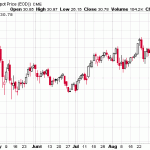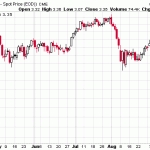It is quite evident looking at bond trading that credit is coming to a halt, very quickly.
First of all, I notice debentures on various firms are plummeting – most of the underlying companies have lots of refinancings ahead in order to make it through. An example of this is Data Group (TSX: DGI.UN), which has had its debentures trade down to 60 cents on the dollar.
Sterling Shoes (TSX: SSI) announced they will not be making their interest payments on their debentures, effectively putting them in default – their interest payment is due on October 31, 2011 and will subsequently lead to a potential default sometime in November according to their prospectus (if enough debenture holders are able to declare a default).
Superior Plus (TSX: SPB) was lucky to get off a $75M debenture financing (with a 5-year term at 7.5%) in the middle of September before their common shares started to fall off a cliff – and took the debentures (series C, D, E, F) with them. Superior Plus is no stranger to this website, having predicted a dividend cut in the past.
Yellow Media is no stranger to this site either, but since I am still licking my wounds on this one, I will leave it at that with this company. Similar to Superior Plus, however, both companies are still free cash flow positive.
First Uranium (TSX: FIU) has had some serious issues regarding their operations and financing, and also some political risk thrown into the mix. As a result, its secured notes have traded down. Indeed, when looking at the management projections for the July to September quarter, management has projected they will be left with about $9 million cash on their balance sheet before they can make a (what they think) turnaround – instead, they just might be ready to default since they also have a CAD$150M debt payment on their unsecured debentures due June 2012. First Uranium is also no stranger to our site, having had the misfortune of investing in their notes and debentures in the past.
Finally, Connacher Oil and Gas (TSX: CLL) has had their common shares annihilated over the past couple months – their unsecured debentures are due on June 30, 2012 and are now trading at 85 cents on the dollar. This is quite interesting in light of the fact that the rest of the company’s debt is structured out until 2018 and they have set up a credit facility to be able to pay off these debentures. The risk is that the company will simply convert the debentures into equity and you end up with another Arctic Glacier (TSX: AG.UN) which underwent a lot of dysfunction after they did the same thing with a very low stock price. Those debenture holders would have been lucky to realize half the value of their debt, or if you timed it perfectly and had a small amount of debt to work with, about two-thirds.
A lot of credit-sensitive companies are trading lower. It is difficult to tell when it will end, but an investor picking up the scraps of companies that will, through organic business performance, be able to bounce back will be very rich – similar to how anybody investing in the corporate debt market in early 2009 made out very well.
Timing indeed is everything.


